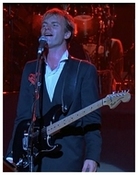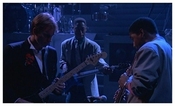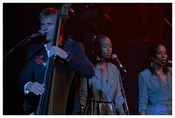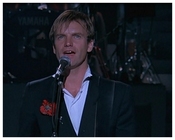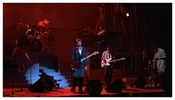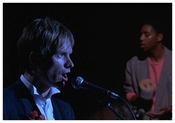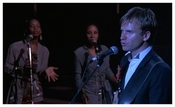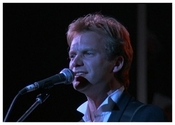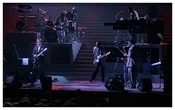
Amnesty's State-of-the-Art Benefit...
The best thing you could once say about benefit concerts was that they are tax-deductible.
Aside from such historic moments as the Concert for Bangladesh, benefits were little more than amateur nights: poor sound, self-indulgent speeches and almost total lack of musical ambition. The artists seemed to think it was enough simply to have donated their services. You want a heartfelt performance, too?
Amnesty International's nearly six-hour ''A Conspiracy of Hope'' concert Friday night at the sold-out 18,600-seat Forum was a dramatic demonstration of how benefits have changed. Lighting and sound were state of the art, the pacing was brisk and many of the artists were more inspiring than they are their own paid concerts.
The concert, the second stop on a six-city tour designed to raise public awareness of the human-rights organization, was headlined by U2 and Sting, and brightened by surprise guest appearances from Bob Dylan, Tom Petty & the Heartbreakers, Live Aid organizer Bob Geldof, Eurythmics' guitarist Dave Stewart and Bonnie Raitt. Among others joining in singing Dylan's 'I Shall Be Released' during the finale: Don Henley, Joni Mitchell and Maria McKee.
There was some unnecessary Hollywood razzle-dazzle (Madonna, Sean Penn and Rosanna Arquette were among the celebs who introduced the acts), and at times the affair seemed to be more a series of individual acts rather than a cohesive package.
Still, the key performances-especially Dylan, Peter Gabriel, Sting and U2-were inspiring in a way that becomes even more prized as you think back on the Bill Graham-produced evening.
It was fitting that the first artist to spark a widespread emotional rush Friday was Dylan, the man who introduced social consciousness to rock in the '60s. Coming on stage after brief sets by the Neville Brothers, Joan Baez, Lou Reed and Jackson Browne, Dylan appeared more confident and animated than he has on stage in years.
He and the Heartbreakers performed three numbers (including his recent 'Band of the Hand' and Faye Adams' '50s gospel/R&B hit, 'Shake a Hand') in a blistering down 'n' dirty rock fashion that made their U.S. tour (it begins tonight at the San Diego Sports Arena) shape up as something special indeed.
Following a brief intermission, Peter Gabriel and his new band put on a dazzling display of sophisticated, synthesizer-based musical textures that brought out both the playfulness of a new song like 'Sledgehammer' and the dark, disheartening undercurrents of 'Biko', a tribute to Steve Biko, the black South African leader who died in prison in 1977.
Sting followed an acoustic Geldof/Stewart teaming on some activist Bob Marley material and Bryan Adams' set of catchy, if less than gripping rock anthems. Still operating in the jazz-accented rock style of his solo tour last year, Sting and his band played with captivating energy and spunk, perhaps best summarizing the message of the evening with an especially warm, outgoing version of 'If You Love Somebody, Set Them Free'.
Though some pop observers questioned the sincerity of Sting's social themes on his solo LP, there seemed little question Friday of his dedication and purpose. His was a show-stopping performance.
Still U2, the Irish rock band, found a way to extend the momentum. The quartet is at its best live where lead singer Bono Hewson becomes a man possessed in trying to establish a special bond with the audience. This band doesn't just want to be good each show, but unforgetable. While the musicians played with driving rock insistence and grace on the opening songs, including 'Pride', a song dedicated to the courage and accomplishments of the Rev. Martin Luther King Jr., Hewson was somewhat reserved, much like a prize fighter looking for an opening.
He found it during an odd dark, rockabilly-tinged coupling of Dylan's 'Maggie's Farm', a personal declaration of independence, and the children's song tune about Old MacDonald's farm. Gazing at the crowd, Hewson asked a fan to hand him the shirt that the fan was waving. Hewson tied it around his head like a blindfold. As the band kept playing, he walked hesitantly to a bank of speakers.
Atop the speakers, Hewson walked the five or six feet to the edge, much like a prisoner going to the firing squad. When he reached the edge of the speaker, Hewson took off the blindfold - a free man again.
By using the blindfold, Hewson reminded us how vulnerable we are; the way we take our sight-and our freedom-for granted. It was a powerful dramatization of Amnesty International's crusade to aid people who have been jailed and/or tortured because of their political or social beliefs. Many people didn't take the time to read the Amnesty pamphlets that were distributed in the lobby, but the image of that blindfolded figure will be hard to shake.
(c) The Los Angeles Times by Robert Hilburn
The best thing you could once say about benefit concerts was that they are tax-deductible.
Aside from such historic moments as the Concert for Bangladesh, benefits were little more than amateur nights: poor sound, self-indulgent speeches and almost total lack of musical ambition. The artists seemed to think it was enough simply to have donated their services. You want a heartfelt performance, too?
Amnesty International's nearly six-hour ''A Conspiracy of Hope'' concert Friday night at the sold-out 18,600-seat Forum was a dramatic demonstration of how benefits have changed. Lighting and sound were state of the art, the pacing was brisk and many of the artists were more inspiring than they are their own paid concerts.
The concert, the second stop on a six-city tour designed to raise public awareness of the human-rights organization, was headlined by U2 and Sting, and brightened by surprise guest appearances from Bob Dylan, Tom Petty & the Heartbreakers, Live Aid organizer Bob Geldof, Eurythmics' guitarist Dave Stewart and Bonnie Raitt. Among others joining in singing Dylan's 'I Shall Be Released' during the finale: Don Henley, Joni Mitchell and Maria McKee.
There was some unnecessary Hollywood razzle-dazzle (Madonna, Sean Penn and Rosanna Arquette were among the celebs who introduced the acts), and at times the affair seemed to be more a series of individual acts rather than a cohesive package.
Still, the key performances-especially Dylan, Peter Gabriel, Sting and U2-were inspiring in a way that becomes even more prized as you think back on the Bill Graham-produced evening.
It was fitting that the first artist to spark a widespread emotional rush Friday was Dylan, the man who introduced social consciousness to rock in the '60s. Coming on stage after brief sets by the Neville Brothers, Joan Baez, Lou Reed and Jackson Browne, Dylan appeared more confident and animated than he has on stage in years.
He and the Heartbreakers performed three numbers (including his recent 'Band of the Hand' and Faye Adams' '50s gospel/R&B hit, 'Shake a Hand') in a blistering down 'n' dirty rock fashion that made their U.S. tour (it begins tonight at the San Diego Sports Arena) shape up as something special indeed.
Following a brief intermission, Peter Gabriel and his new band put on a dazzling display of sophisticated, synthesizer-based musical textures that brought out both the playfulness of a new song like 'Sledgehammer' and the dark, disheartening undercurrents of 'Biko', a tribute to Steve Biko, the black South African leader who died in prison in 1977.
Sting followed an acoustic Geldof/Stewart teaming on some activist Bob Marley material and Bryan Adams' set of catchy, if less than gripping rock anthems. Still operating in the jazz-accented rock style of his solo tour last year, Sting and his band played with captivating energy and spunk, perhaps best summarizing the message of the evening with an especially warm, outgoing version of 'If You Love Somebody, Set Them Free'.
Though some pop observers questioned the sincerity of Sting's social themes on his solo LP, there seemed little question Friday of his dedication and purpose. His was a show-stopping performance.
Still U2, the Irish rock band, found a way to extend the momentum. The quartet is at its best live where lead singer Bono Hewson becomes a man possessed in trying to establish a special bond with the audience. This band doesn't just want to be good each show, but unforgetable. While the musicians played with driving rock insistence and grace on the opening songs, including 'Pride', a song dedicated to the courage and accomplishments of the Rev. Martin Luther King Jr., Hewson was somewhat reserved, much like a prize fighter looking for an opening.
He found it during an odd dark, rockabilly-tinged coupling of Dylan's 'Maggie's Farm', a personal declaration of independence, and the children's song tune about Old MacDonald's farm. Gazing at the crowd, Hewson asked a fan to hand him the shirt that the fan was waving. Hewson tied it around his head like a blindfold. As the band kept playing, he walked hesitantly to a bank of speakers.
Atop the speakers, Hewson walked the five or six feet to the edge, much like a prisoner going to the firing squad. When he reached the edge of the speaker, Hewson took off the blindfold - a free man again.
By using the blindfold, Hewson reminded us how vulnerable we are; the way we take our sight-and our freedom-for granted. It was a powerful dramatization of Amnesty International's crusade to aid people who have been jailed and/or tortured because of their political or social beliefs. Many people didn't take the time to read the Amnesty pamphlets that were distributed in the lobby, but the image of that blindfolded figure will be hard to shake.
(c) The Los Angeles Times by Robert Hilburn

